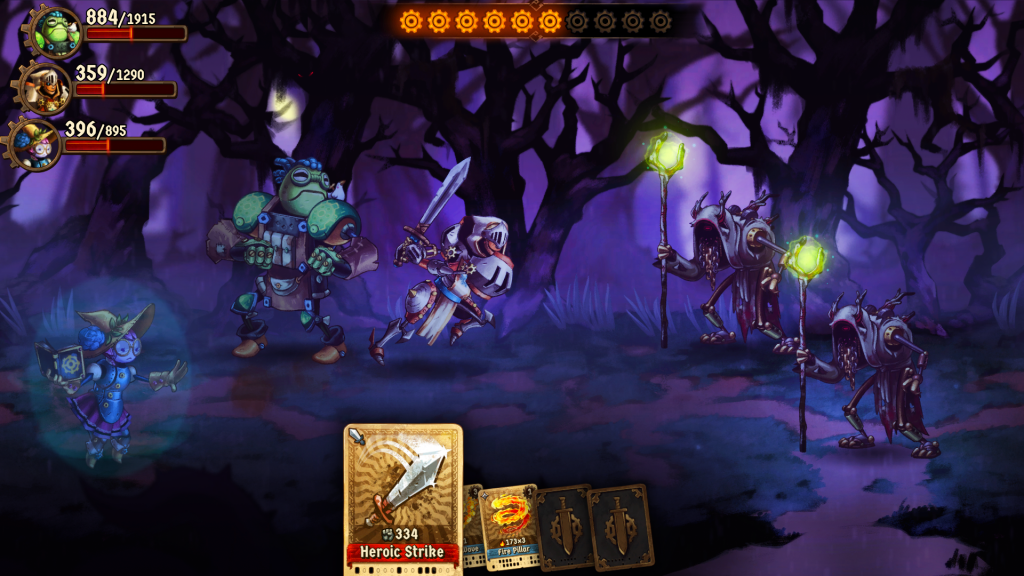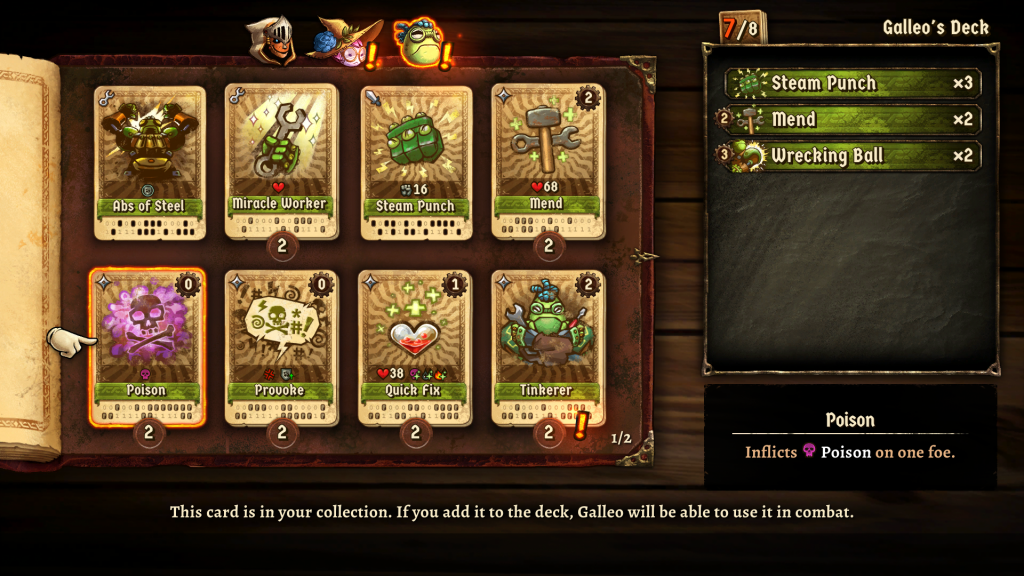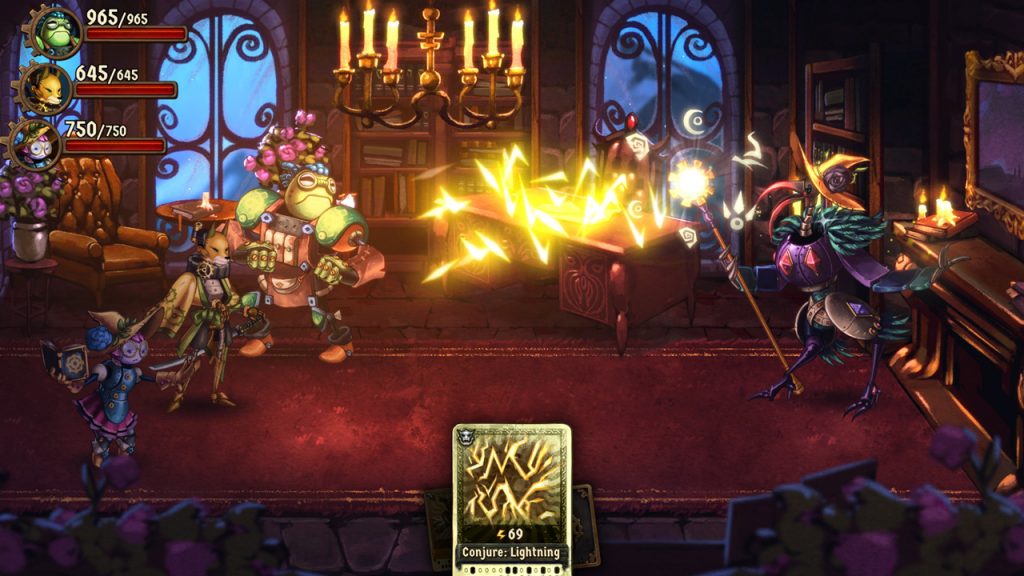- Switch
This is a very hard review to write. It’s one thing to be let down by a game you’re excited for but quite another when it’s so excruciatingly close to being great… but ends up only okay. By any measure, SteamWorld Quest should be extremely my jam—it’s a deckbuilding RPG, it’s on the Switch, and it’s the latest game in one of the low-key best game series in recent memory. (Go play SteamWorld Heist right now, if you haven’t.) But there’s a stack of little imperfections that compounded and held me back from enjoying the game as much as I thought I would. It’s like the uncanny valley effect—the game is so close to being great that all the little flaws became much more glaring. However, with some small tweaks, I think Image & Form could turn things around. My fingers are crossed, because I really wanted to love this game.
SteamWorld Quest is a deckbuilding RPG that bucks recent trends in the subgenre by eschewing roguelike design for a traditional linear narrative. The story is your classic “ragtag crew of quirky youths band together to stop an apocalypse after their town gets sacked” story, but like the rest of the SteamWorld games, everyone is a robot. The story beats are by the numbers, but the main cast of characters are charmingly written and generally inoffensive. Unfortunately, the game’s relative brevity (10-20 hours depending on how thorough you want to be/how hard of a time you have) doesn’t give the characters much room to grow, especially those introduced later in the game. The art is gorgeous, as all the HD entries in the series have been. I enjoyed the super expressive paper doll-style animation especially.

The story and cast are nice, but with a deckbuilding game, what keeps me going is the actual building of decks, y’know? SteamWorld Quest has some pretty cool takes on the deckbuilding RPG concept, but not quite all of it comes together. Here are the basics: You have a pool of characters in your party, that grows over the course of the story. Each character has an ever-expanding selection of cards, of which you choose eight to build their deck for battle. Each character has a general archetype, with no cards shared between characters. Of your available characters, you select three as your active party via the pause menu outside of battle.
Outside of battle, you control one of your party members and move through a series of connected screens, almost like a beat-em-up. Enemies roam these screens, and making contact with one begins a battle, with the option to do a little damage if you manage to hit them with the attack button before they run into you. (The damage is pretty marginal, which is a blessing because the otherwise gorgeous paper doll art style makes it incredibly challenging to line up the hits.)
The battle begins, and a hand of your selected characters’ cards are drawn. SteamWorld Quest’s take on deckbuilding card costs is Steam, represented by a series of cogs that light up at the top of the screen as Steam builds. Steam builds by playing cards that do not have a Steam cost in their upper-right corner. These cards are your basic attacks and (de)buffs, but as you unlock more cards from crafting and questing some more interesting options come into play. Beyond steam costs, you are limited to playing three cards per turn. However, if you play three cards from the same character, a chain effect is triggered, based on the weapon they have equipped. But maybe you have a card with an extra effect that triggers if played after a card of another character, which prevents you from getting that chain effect. Of course, like any decent card game, there are cards that bend these systems, too. When it all works, it’s a really fun, crunchy system with interesting decisions almost every turn.

Unfortunately, it doesn’t always work, thanks to some small issues that can grind everything to a halt. My first issue is that, thanks to the way enemy encounters work, it’s possible to get blindsided by an enemy that your current active party is entirely unequipped to handle. There’s occasions where an enemy joins the battle once it’s initiated that has an elemental strength or weakness, or some card that your deck can’t do anything about thanks to the characters you’ve selected. Generally the enemies in an area tend to follow a certain theme, which is appreciated, but figuring out that theme can be frustrating.
There is an option to flee from any normal battle, which makes you sit through an enemy turn, but that can leave you in a pretty rough spot through no fault of your own. Unfortunately, the flee option is not enabled for boss fights, which are already difficult even with a decently-crafted deck, and sometimes do not follow the general enemy theme of an area. There were two occasions where I just mashed “end turn” until a boss wiped out my party so I could tweak my deck and try again.

And while there is a prompt to “skip cutscene” by pressing B, it only skips chunks of dialogue instead of going straight to the battle. These frustrations led me to focus on building generalist decks to try and avoid restarting or losing party members as much as possible, and for a deckbuilding game, that is really boring. The best part of these games for me is coming up with hyper-specialized decks that are borderline broken in the right circumstance. Maybe that’s just me, and none of this will be a problem for you. And honestly, I hope that’s the case. You deserve to have a better time with this game than me.
After some thought, I came up with a solution I think would solve most of the issues I have: let me swap out party members at the very beginning of the battle, before any cards are drawn. I don’t think this would destroy the difficulty curve like being able to rebuild your whole deck at the same point. It’s just enough to go “Hey, now that this lightning guy is here that wasn’t in the overworld, maybe I should get Galleo in there,” and start the battle. I think Celeste’s accessibility options and especially the “cheats” in recent Final Fantasy ports ruined me on issues like this. It’s a single-player game, why shouldn’t there be more options to tweak the difficulty and other quality of life features? Make it an option in a menu, like the (very welcome) option to speed up all animations that’s already there.
It’s such a bummer that these minor interface and game flow issues hold back a charming game filled with some genuinely great systems, but I’m hopeful that Image & Form will take feedback into account. It’s a good game that could be great with just a little more polish, and if that happens I will gladly dive back in. But until then, I would recommend going in with managed expectations.



I am enjoying it so far. Not sure how far through I am, but I have a roster of 5 heroes and never enough cash to craft or upgrade the cards I would like. Having said that I have figured a way to handle most encounters with my selected party, though some boss fights are close. I don’t do the character combos because the icons are too small to identify who they are, but always try for the single character bonus if it works.